Sand nourishments
Sand nourishments are the mechanical placement of sand in the coastal zone to advance the shoreline or to maintain the volume of sand in the littoral system.
|
Thema |
Waterveiligheid, Het kustsysteem |
|
Tags |
|
|
Downloads |
- INTRODUCTION
- RELATED TOPICS AND DELTA FACTS
- STRATEGY: WORKING WITH NATURE
- SCHEMATIC
- TECHNICAL CHARACTERISTICS
- GOVERNANCE
- COSTS AND BENEFITS
- LESSONS LEARNED AND ONGOING STUDY
- KNOWLEDGE GAPS
- EXPERIENCES
Introduction
Beaches and dunes play an important role in the protection and maintenance of coastal areas by attenuating wave energy, preventing floods and reducing erosion. Physical interventions can lead to a reduction in sediment supply locally or elsewhere on the coast and hence to the deterioration of the natural function. Recharge or nourishment of dunes, intertidal or nearshore areas with sediment can restore the functions of the coastal area. At the same time, nourishments may enhance the associated habitat value and (ecosystem) functions. Nourishments are a more natural coastal defence option than ‘hard alternatives’ such as concrete seawalls, rock revetments, timber groynes, offshore breakwaters, etc. This fact sheet deals with the nourishment of beaches using sand.
Sand nourishments are the mechanical placement of sand in the coastal zone to advance the shoreline or to maintain the volume of sand in the littoral system. It is a measure to stabilize the shoreline and support the flood or erosion protection function of the coast (Wesenbeeck et al, 2012). It maintains the historical landscape of the coastline, while hard measures (seawalls, breakwaters, etc.) may change the coastline significantly. Also, sand nourishment may increase the recreational value of the beach and dunes. Since sand nourishment keep natural gradients (wet-dry, salt-fresh, shallow-deep) intact, the coastal ecosystem will benefit (Marchand et al, 2012). Besides marine coastal areas, sand nourishments are also applied on lake coasts.
Examples of areas where sandy shorelines are managed through nourishments are the Netherlands, Florida, UK, Denmark, Germany, France, Spain, Portugal, Australia and Hawaii (Wesenbeeck et al, 2012).
Related topics and Delta Facts
Key words: Managed realignment, beneficial re-use of dredged material, working with nature
Related Delta Facts: Managed realignment, Beneficial re-use of dredged material
Strategy: Working with nature
Sand nourishments are based on a strategy of ‘working with nature’. Working-with-nature is an approach in which optimal use is made of natural dynamics such as wind, water, sediment and vegetation and may lead to a positive effect on nature. Working with Nature solutions contribute to multifunctional land use, such as nature development, flood risk management, fresh water supply, fisheries, recreation and infrastructure.
The use of natural dynamics leads to solutions that are more adaptable in anticipating to (uncertain) changing, natural or socio-economic conditions. On the other hand, natural dynamics are inherently less predictable due to variability of weather conditions but also the complexity of ecological and morphological processes. Therefore working with nature solutions require adaptive pathways for decision-making and an adaptive governance approach to facilitate implementation and maintenance of the working-with-nature solutions. Adaptive pathways include the use of multiple scenarios on future socio-economic and physical developments (e.g. climate change or land-use) and possible actions. An adaptive governance approach includes principles of continuous and collective learning to include new insights and knowledge, a participatory monitoring program, wide participation of stakeholders, and a continues process of reflexive decision-making. This is contrary to more conventional approaches where after implementation projects are finished. The dynamic and unpredictable character of working with nature solutions, require a continuous process of decision-making.
Similar concepts to working with nature are ‘building with nature’, ‘eco-engineering’, ‘ecological enhancement’ and other.
Schematic
The process of erosion
Sandy beaches dissipate wave energy. They are part of a dynamic system, which continuously reacts to constantly changing wave climates and sea levels. As such, the volume of sand held upon a beach is also constantly fluctuating.
When there is too much erosion, the coast will retreat and may even result in flooding of the land behind the dunes. When the system is resilient it can replenish the sand lost up to a certain amount. After a storm, part of the sediment may return to the coast through onshore directed wave- and wind-driven transport, resulting in accretion in the beach zone. However, long-shore currents may also move the sediment further away from the original location.
The idea of sand nourishments is to enhance the natural resilience of the sandy coast. By adding sand to a system with insufficient supply too keep the coastline in place (Marchand et al, 2012). Several studies showed that sand nourishments are an effective measure against erosion.
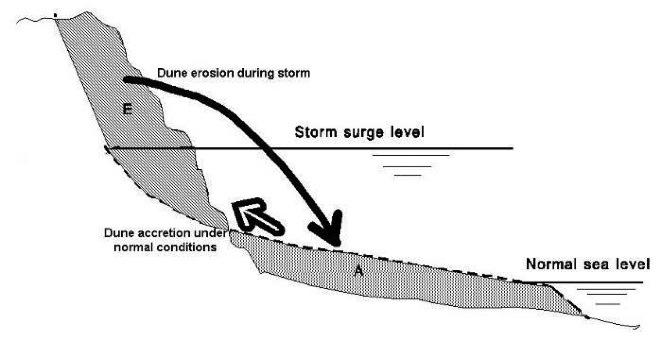
Figure 3. Basic process of coastal erosion and accretion (Marchand et al, 2012)
Types of sand nourishments
Three types of sand nourishments are distinguished: dune nourishments, beach (intertidal) nourishments and nearshore/shore face nourishments (Fig 1).
Dune reinforcements: there are two types of dune reinforcement, landward or seaward dune reinforcement. The dunes are protected landward or seaward against breaching during storms.
Beach nourishments: sand is dumped and distributed as high as possible on the beach to use as a buffer layer or continuous source of sand depending on the location;
Shore face nourishments: berms or mounds are constructed near the shore to feed the beach or berm in more shallow water or as a reef berm in deeper water to act as a barrier for storm waves;
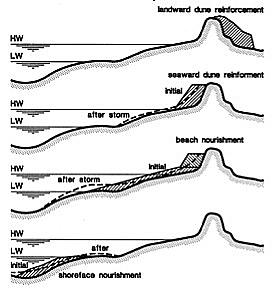
- Figure 1. Different types of sand nourishments (Marchand et al, 2012)
Technical characteristics
The sand nourishment process
To execute a shore face nourishment a ship places sand just before the coastline. The sandbank produced will break the waves, which will facilitate sand transportation to the coast. For beach and dune nourishments sand is transported by means of a pipeline to the beach or transported from the inland. Bulldozers then divide the sand over the beach. The beach and dune nourishment methods have a direct effect on the width of the beach, while the effect of the fore shore and shore face nourishment will take longer to affect the beach (Rijkswaterstaat, 2012). Currently, a new type of sand nourishment is applied in the Netherlands: the sand engine. This so called mega nourishment (of 20 million m3) applies an extra amount of sand that will be redistributed by wind and waves (comparable to the shore face/ fore shore nourishment).
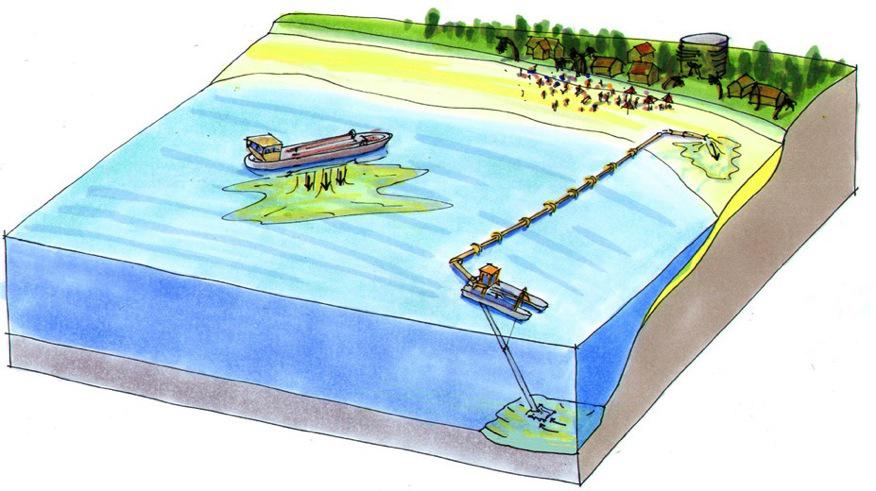
Figure 2. Sand nourishment methods (Stronkhorst et al, 2013)
Sources of sand for sand nourishments vary. Sand mining is a method to collect sand from the offshore seabed. Other sources for sand are rivers or inland sandstone quarries (Stronkhorst et al, 2013). The sandstone may be crushed and transported to the coast, for example as slurry through a pipeline. Where it is available, the beneficial re-use of sediment arising from for example navigation related dredging activities may provide a cost-effective solution.
Suitable locations/conditions for sand nourishments
Sandy coasts are most suitable for sand nourishments. The scale of the nourishments has to take into account the physical nature of the coast (e.g. a long length of uninterupred beaches vs. small bays and/or multiple channels) and the administrative arrangements (if an investiment is being made by one municipality, the loss of sand to neighboring sections needs to be considered. A suitable location tends to have a sand source close by (Marchand et al, 2012) and must be cost effective in relation to other alternatives. Furthermore, sand nourishments are suitable when the result legitimizes the investment. Therefore, sand nourishments are often performed for beaches with a recreational function or otherwise have (economic) value (interview Joost Stronkhorst).
The success of a nourishment scheme depends on the grain size of the nourished sand - the so-called borrow material - relative to the grain size of the native sand. If the borrow sand is finer than the native sand, the profile will be flatter than the natural one. If you want to obtain a wider beach, large volumes of sand are required. A larger grain size than the native sand will achieve the opposite, it will steepen the profile and less sand is required to obtain a wider beach (Haney et al, 2007).
Another important condition for sand nourishments relates to the maintenance efforts. Sand nourishments require ongoing maintenance in order to be a suitable long-term solution against erosion. In addition, this requires a permanent well-functioning organization performing the sand nourishments.
Effects on the Ecology
In literature different views exist on the impact of sand mining and nourishments on marine and coastal ecology.
Most studies show that marine sand mining cause a disruption of habitats, transitory fishes and marine mammals. Mainly beach and dune nourishments (negatively) influence the marine and coastal ecology, shore face nourishment has more positive impacts.
A study on the Anping coast in Taiwan, demonstrated that both biotic and abiotic parameters show significant differences before and after sand nourishments. Biological conditions became worse in the early stages of the nourishment but improved after the work was completed. The composition of benthic invertebrates changed, while two groups (Bivalvia and Gastropoda) seemed to be particularly suitable to the habitat after the beach nourishments (Shih et al, 2011). An eastern Australia study on the effects of beach nourishment on benthic invertebrates indicated that the negative effects of beach nourishment on the fauna were massive on the upper and middle levels of the beach. Fewer effects were shown on the lower shore. After five months the upper level of the beach until the dunes were not recovered, while the middle shore partly and the lower shore totally recovered (Schlacher et al, 2012). A Dutch study on the effects of beach nourishment on intertidal macro-invertebrates indicated that the effects of sand nourishment on species would be mainly species specific (Leewis et al, 2012). A study on the effects of sand nourishment on the dune ecology indicated that the effects on fauna were large on the sand nourishment locations, but were smaller on the fauna in the dunes. The dynamics in the dune area increased, which seems to lead to a larger variation in fauna (Arens et al, 2012). A study on soil and vegetation characteristics showed a limited effect of sand nourishments on pH, organic matter content and nutrient composition of vegetation. The only effect was a larger supply of calcic sand due to the higher calcic content of nourished sand (Stuyfzand et al., 2012). Machand concludes that in the long term, sand nourishments enlarge the transition area between dry and wet, deep and shallow, sea and land, which may lead to a high biodiversity (Marchand et al, 2012).
Alternatives to beach nourishment
Traditional alternatives to sand nourishment are hard coastal structures such as groynes, revetments, seawalls and detached breakwaters. These are built to reduce coastal beach erosion and to maintain a minimum beach for recreation. Seawalls or revetments run parallel to the shore, which prevent erosion of the beaches inside the wall. Groynes and breakwaters run perpendicular to the shore protecting the shore from erosion. Seawalls and revetments are typically built in regions where natural dunes are absent; these measures are not applicable on every location. In addition, building hard structures on locations with dunes may decrease its recreational value (Conscience, 2013). Hard structures are furthermore local solutions, and erosion may be displaced to another location.
Alternative measures with a more ‘soft’ working-with nature character include planting marram grass (Ammophila arenaria), building fences (of natural material), conservation of wetlands along the coast and replacing dikes, dams or levees for wetlands. Marram grass will fixate the foredunes, which will partly prevent erosion (Wesenbeeck et al, 2012). Fences on the seaward side of a dune will trap sand and stabilise sand surfaces, these fences are often made of branches or reed stakes (USACE, 2003).
Governance
The governance of sand nourishments is highly dependent on the country of execution and the specific location. However, aligning the interest of authorities, stakeholders and the public is critical to getting working with nature projects implemented. This is in particular relevant as sand nourishments are not a local solution compared to hard structures such as break waters (Interview Joost Stronkhorst). In fact, local hard structure may undermine the functioning of the sand nourishment, which is why stakeholders involved in the entire coastal area under influence should support the approach (id). One of the challenges for sand nourishments is involvement of stakeholders from different policy domains. This is in particular relevant as the sand nourishment may contribute to multiple user functions such as nature and recreation (Janssen, 2011). Sand nourishments are an adaptive form of flood protection. This means the organisation should be in a form of adaptive management. Adaptive management includes a close monitoring program of the changing state of the coast and recurrent interventions supported by agreement of involved stakeholders. Responsibilities, budget rules and public information should be set up between the governmental organisations on different levels (Marchand et al, 2012). An interesting example of adaptive management of the sand nourishment approach is the organisation of the Dutch coastal maintenance program, involving a yearly assessment of the state of the coastline and decision-making procedure (Janssen, 2011).
A process of co-creation where stakeholders work together with developers will be more successful than just presenting technical designs (De Vriend & Van Koningsveld, 2012). The involvement of the end-users in the implementation of Building-with-Nature solutions is needed right from the start (Borsje et al, 2010).
Between European countries there are significant differences in organisation of sand nourishments. The Netherlands and Denmark are the only countries that have overall performance evaluation programs integrated into their legal framework. Germany, The Netherlands, Denmark and the United Kingdom have developed a long-term strategy for actions along the coast and following up programs, while Spain, Italy and France lack an overall long-term strategy. Also financial support is in the last two countries a problem. However, it is foreseen that there will be a continuation of a transfer from hard to soft measures for dealing with coastal erosion in Europe. In 2002 Spain and the Netherlands were frontrunners in Europe, they had the largest fill volume of sand per meter of coast per year (Hanson et al, 2002).
Costs and benefits
The costs of a sand nourishment largely depends on the availability of sand, the distance to the project area and the type of nourishment. Beach and dune nourishments are considerably more expensive than shore face nourishments, due to the use of bulldozers to spread the sand and indirect costs of disrupting beach tourism. The unit price of sand ranges between €3 and €5 per cubic meter but depends on location, distance between the sand mining and the nourishment location and the market conditions. Prices may increase towards €10 per cubic meter. Sand nourishments can only succeed if the costs can compete with other solutions or yield sufficient benefits. The distance to the nearest sediment reservoir is one of the largest factors determining the price per cubic metre of sand (Marchand et al, 2012).
Sand nourishment as a coastal defence strategy is not necessarily cheaper than hard structures. Typically hard structures have high capital investment costs, while the costs of maintenance are higher for sand nourishment (Conscience, 2013). However, sand nourishments may yield more benefits for other purposes than flood risk alone, it may function as a more sustainable solution to handle coastal erosion and it may be more beneficial for the ecosystem. Ecosystem and environmental value are difficult to monetize. There are indirect benefits, such as increase in land value near the sea, additional income for local businesses and jobs. In Bali for example, the number of beach visitors increased 2,5 times after a beach restoration project (Marchand et al, 2012).
Sand nourishments have a restricted lifetime (e.g. in the Netherlands the regular nourishments have a life time of about 4 to 5 years) and consequently require regular investments. The lifetime depends on the rate of erosion and the distance to the sediment reservoir. This shows that the effectiveness of sand nourishments on the long term depends on continuation and commitment (Marchand et al, 2012).
Lessons learned and ongoing study
In the Netherlands a lot of research is devoted to the topic of sand nourishments. The national coastline maintenance programme of executing sand nourishments is accompanied by an extensive monitoring program. In addition a research program is executed called ‘coastline care’ (In Dutch kustlijnzorg). This research program aims to increase insights into the functioning of the sandy system and ecological effects.
In the Building with Nature innovation program research has been, and is being, performed on (large-scale) sand nourishments. In this innovation program, physical, ecological and governance topics are addressed. More information and lessons learned on sandy shores are found on: http://ecoshape.nl/en_GB/wiki-environments.html/environment/253-Environment+-+Sandy+Shores.
Recently a new research program has started called NatureCoast, addressing the physical and governance aspects of sand nourishments using natural dynamics (‘nature-driven’). http://stw.nl/nl/programmas/nature-driven-nourishment-coastal-systems-naturecoast.
Knowledge gaps
There are several knowledge gaps regarding the effects of sand nourishments on ecology. Mainly the long-term effects on the ecology are lacking. Other gaps relate to the effect of sand drift on the biodiversity, the effect of a changing habitat due to sand nourishment on primary production and fisheries communities, the effect of noise and light disturbance on marine mammals during sand nourishments and the effect of new sandbanks on marine mammals (Stronkhorst et al, 2010).
The dynamics of sand after sand nourishments differ per location. These vary from stabilization of the area to intensive sand drifts to the dunes. The reason of this variation is still unknown (Arens et al, 2012).
Sea level rise changes the necessary sand volume to stabilize the coastal area. Currently, there are predictions how the coastal area will develop due to the sand nourishments. However, there are large uncertainties in these predictions (Stronkhorst et al, 2010).
The effects of large-scale sand nourishments on the geo-morphology, ecology and recreation needs to be studied. The results of the ‘sand engine’ project in the Netherlands will reduce these knowledge gaps.
Limited studies are available on the economic benefits of sand nourishment projects on recreation. Most policy makers assume a positive relation, while the size of this relation is not clear.
Experiences
Sand Engine
The sand engine is a large-scale sand nourishment located in front of the Dutch coastline that will be redistributed by wind and wave energy, stimulating nature development of the coasts. It will serve more functions than flood protection alone, such as increasing a buffer zone, enlarging the coastal intertidal zone benefitting nature a recreation. In 2011 the sand engine was constructed. It extends 1 km into the sea and is 2 km wide joining the coast. The sand engine is created by mining sand ten kilometres off the coast. The total costs for this project are €70 million, from which the national government contributed €58 million and the province €12 million. The sand engine has an expected lifetime of 20 years, relieving sand nourishment efforts for this period. There are still many uncertainties, for example regarding the speed of the sand dispersal and hence the lifetime the nourishment, but also the formation of gullies and cliffs affecting swimmers safety. These effects are intensively monitored. The expected benefits are the added recreational value, nature development and knowledge acquired by executing this project (Marchand et al, 2012; Janssen, 2011).
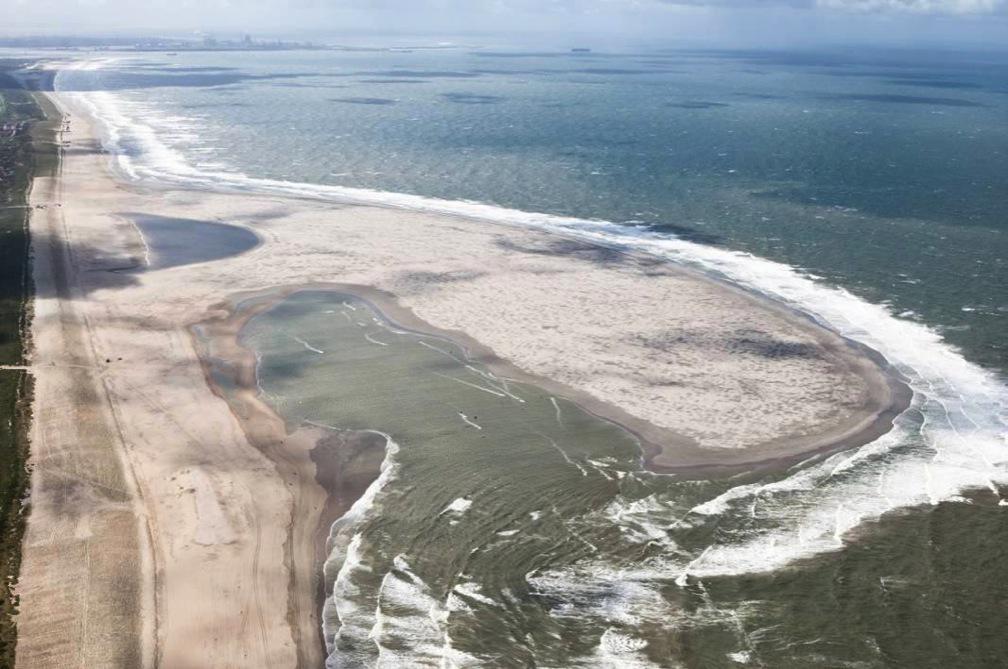
Figure 4. Sand engine
Workumerwaard
In 2011, 20.000 m3 of sand were deposited 200 metres off the Workumerwaard in a large fresh water lake in the Netherlands. This is a nature reserve and bird sanctuary, one of the many natural wetland areas on the eastern shore of the Ijssel lake (A large lake in the middle of the Netherlands enclosed by a large man-made dike (Afsluitdijk)). Vegetation in this area is losing diversity and vitality, and the experiment aims to see if the ‘sand engine’ would help to revitalize it. Observations show that so far the movement of sand onshore has been rather slow, although the process was accelerated by the action of ice piling up during the harsh winter at the start of 2012. It is too early to judge whether the experiment has been a success. Other sand engines are planned on different locations along the Ijsselmeer coastline aiming to protect the IJsselmeer dikes or compensating beach erosion (De Vriend & Van Koningsveld, 2012).
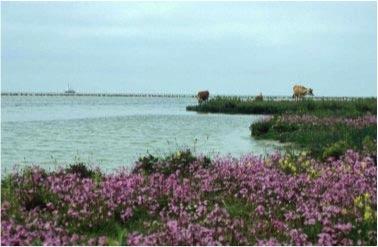
Figure 5. The Workumerwaard (http://www.grootsneek.nl/wp-content/uploads/2010/11/warkumerwaard.jpg)

 English resume
English resume